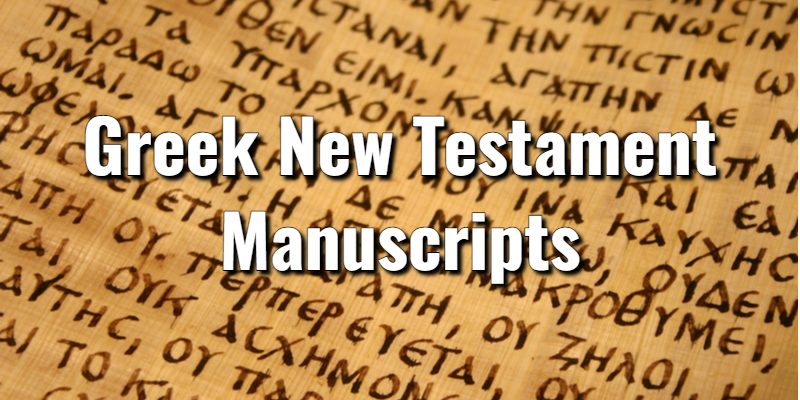Lord’s Library editors compiled this resource about the Greek New Testament Manuscripts and the main textual traditions that accompany them.
The Bible has a long history behind it. To understand the different New Testament manuscript families from which translators do their work of bringing the Bible into people’s native vernaculars, we must first understand how the Bible came to be and how it was passed down over time.
The first thing we must keep in mind is that the printing press was not invented until the 1400s. Today, we print as many copies of books as we want. With modern technology, we can guarantee that these books are identical to one another in every way. But for all of history before that, this wasn’t an option that was available.
The biblical authors wrote their books of the Bible by hand. Starting with Moses in about 1300 B.C. and ending with the Apostle John in roughly 95 A.D., the Bible wasn’t written at once. The authors also did not have the luxury of having digital copies of their work, only handwritten ones. So, the Bible came about by combining a century and a half of handwritten work by multiple people.
These books have always been and continue to be of extreme importance to believers around the world. That’s why they have survived throughout history, even during times of extreme persecution. The fact that these manuscripts were able to survive and be passed down to us today is only by divine intervention!
Just imagine for a moment the immeasurable level of work required to replicate biblical manuscripts by hand. And back in those times, they didn’t have infinite amounts of paper, pens, or ink by which to do it! Even preparing papyrus on which to write was a process in and of itself. Papyrus was prepared by cutting down stalks of the papyrus plant, peeling away the outer green fibers, slicing the core fibers into thin strips, soaking the strips in water for several days and intermittingly rolling them out, drying them, and rubbing the sheet smooth with a stone. The entire process could take up to a month!
This made the process of copying biblical manuscripts costly, time-consuming, and requiring skills that your average person didn’t have. We must remember that in those times, your average person wasn’t even literate in reading and writing. Educated scribes had to take up the task of producing copies of biblical manuscripts.
There are over 5700 extant manuscripts of the Greek New Testament. These manuscripts were created in different times and places. The three main textual traditions identified by scholars are based on these factors and key identifying characteristics within the text itself. Most scholars agree on these three main text types, though a few others exist which some scholars will argue for (such as the Cesarean).
Greek New Testament Manuscripts
What Exactly is a “Textual Tradition?”
Translation is not code-breaking. In fact, there is no such thing as a 100% word-for-word translation of the Bible. Changes in grammar, language, syntax, and culture over the years make such a task impossible. That means that every translation, is in fact, an interpretation. Textual traditions are different patterns of translation that scholars see appear in manuscripts of the Greek New Testament. These patterns are typically associated with certain places from which these manuscripts originated, hence the names they have been given (Alexandrian, Byzantine, and Western).
Textual traditions are important for the continued work of translating the most accurate Bible possible. They help us to determine patterns and find the places where the text may have been altered for a specific purpose. Through the study of these textual traditions, scholars have been able to learn an unbelievable amount about how these manuscripts came to be and which ones are best to use in translating the Bible.
This knowledge has served us in the past by making our modern Bible translations as accurate as they can be. It will continue to serve us in the future as even more accurate translations are brought into existence by new finds in the study of these manuscripts.
So, what are the three main textual traditions (or text-types) identified by biblical scholars?

Alexandrian Text-Type
The Alexandrian textual family is usually considered the oldest and most faithful in preserving the original text of the New Testament. Both Codex Sinaiticus and Codex Vaticanus contain this text type. The Alexandrian text type is characterized by a focus on keeping passages as brief as possible.
For example, this text type concludes the Gospel of Mark at 16:8 and removes the story of the adulterous woman in John 8, both of which lack early manuscript support. This does not mean that these stories are necessarily wrong but simply may have been placed there after the initial writing of these Gospels.
Byzantine Text-Type
The majority of Greek manuscripts are from the Byzantine textual family. This is the text type from which the Textus Receptus was developed. Textus receptus means the “received text,” or the text that has been accepted universally as authoritative since around 1624. It was originally published by the Christian theologians Erasmus. The Textus Receptus was the source for most early English versions of the New Testament.
Most scholars have long considered the Byzantine text type less accurate and of lower quality than the earlier Alexandrian family. It is characterized by the replacement of difficult language with easier terms. For example, Matthew 6:1 says, “Take heed lest you do your alms [Greek, “righteousness” or acts of religious devotion] before men.” The Byzantine text replaces “righteousness” with “alms.”
Western Text-Type
The Western family is often found in manuscripts that contain both the Greek and the Latin New Testament. This family is represented by Codex Bezae, Codex Claromontanus (in Paul’s letters), as well as the writings of the Syriac Church Fathers. These text types are characterized by extensive paraphrasing which results in addition, omission, substitution, and “improvement” of the text.
A prominent example of Western text-types is the entire book of Acts. In the Western text-type manuscripts, Acts is significantly longer than it is in the other text types. Why? Because of the use of extensive paraphrasing. Stories are extended dramatically and increase the overall volume of the book.
Final Thoughts
The main difference between these text-types is the particular focuses of the translators as they were translated. The Alexandrian manuscripts prefer brevity, while the Byzantine ones focus on replacing difficult language with easier wording, and the Western type extensively uses paraphrase. While there are other features of each text-type, these are the main ones by which they are distinguished from one another.
The continued research of Greek New Testament manuscripts will only serve to help us understand God’s Word more accurately and create more faithful translations of the Bible. I pray that this article has enlightened you on the existence and importance of the different textual traditions present in the extant Greek New Testament manuscripts.
Lord's Library participates in affiliate programs. We may make a small commission from products purchased through this resource.
- The 6 Best 1 Corinthians Commentaries to Read in 2025 - March 24, 2025
- The 8 Best 1 Corinthians Bible Study Books to Read in 2025 - March 24, 2025
- 2 Timothy 1:9-10 Meaning: Commentary on Important Scriptures - March 22, 2025












